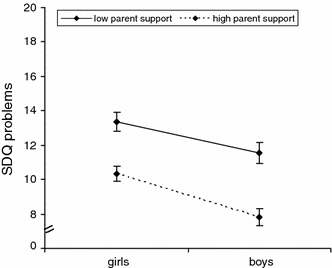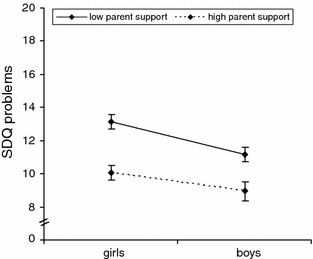Peer-victimization and mental health problems in adolescents: are parental and school support protective?
- PMID: 20221691
- PMCID: PMC2861171
- DOI: 10.1007/s10578-010-0174-5
Peer-victimization and mental health problems in adolescents: are parental and school support protective?
Abstract
The aim of this study was to investigate the frequency and effects of peer-victimization on mental health problems among adolescents. Parental and school support were assumed as protective factors that might interact with one another in acting as buffers for adolescents against the risk of peer-victimization. Besides these protective factors, age and gender were additionally considered as moderating factors. The Social and Health Assessment survey was conducted among 986 students aged 11-18 years in order to assess peer-victimization, risk and protective factors and mental health problems. For mental health problems, the Strengths and Difficulties Questionnaire (SDQ) was used. Effects of peer-victimization on mental health problems were additionally compared with normative SDQ data in order to obtain information about clinically relevant psychopathology in our study sample. Results of this study show that peer-victimization carries a serious risk for mental health problems in adolescents. School support is effective in both male and female adolescents by acting as a buffer against the effect of victimization, and school support gains increasing importance in more senior students. Parental support seems to be protective against maladjustment, especially in peer-victimized girls entering secondary school. Since the effect of peer-victimization can be reduced by parental and school support, educational interventions are of great importance in cases of peer-victimization.
Figures






Similar articles
-
Factors Associated With Peer Victimization Among Adolescents in Taiwan.J Nurs Res. 2018 Feb;26(1):52-59. doi: 10.1097/JNR.0000000000000195. J Nurs Res. 2018. PMID: 29315206
-
Peer Victimization and Adolescent Mental Health: School-level Victimization as a Moderator.J Interpers Violence. 2024 Nov;39(21-22):4647-4666. doi: 10.1177/08862605241244473. Epub 2024 Apr 8. J Interpers Violence. 2024. PMID: 38587277
-
Daily school peer victimization experiences among Mexican-American adolescents: associations with psychosocial, physical and school adjustment.J Youth Adolesc. 2013 Dec;42(12):1775-88. doi: 10.1007/s10964-012-9874-4. Epub 2012 Dec 14. J Youth Adolesc. 2013. PMID: 23238764 Free PMC article.
-
The role of school race/ethnic composition in mental health outcomes: A systematic literature review.J Adolesc. 2019 Jul;74:71-82. doi: 10.1016/j.adolescence.2019.05.006. Epub 2019 Jun 3. J Adolesc. 2019. PMID: 31170600 Free PMC article.
-
Feeling Unsafe at School and Associated Mental Health Difficulties among Children and Adolescents: A Systematic Review.Children (Basel). 2021 Mar 17;8(3):232. doi: 10.3390/children8030232. Children (Basel). 2021. PMID: 33802967 Free PMC article. Review.
Cited by
-
Analysis of school support: Systematic literature review of core Chinese- and English-language journals published in 2000-2021.Front Psychol. 2022 Aug 8;13:933695. doi: 10.3389/fpsyg.2022.933695. eCollection 2022. Front Psychol. 2022. PMID: 36003103 Free PMC article.
-
Everything's Gonna be Alright! The Longitudinal Interplay among Social Support, Peer Victimization, and Depressive Symptoms.J Youth Adolesc. 2017 Sep;46(9):1999-2014. doi: 10.1007/s10964-017-0653-0. Epub 2017 Mar 17. J Youth Adolesc. 2017. PMID: 28315187
-
Extracurricular activity participation moderates impact of family and school factors on adolescents' disruptive behavioural problems.BMC Public Health. 2015 Nov 11;15:1110. doi: 10.1186/s12889-015-2464-0. BMC Public Health. 2015. PMID: 26558510 Free PMC article.
-
Anxiety disorders and risk for alcohol use disorders: the moderating effect of parental support.Drug Alcohol Depend. 2014 Jul 1;140:191-7. doi: 10.1016/j.drugalcdep.2014.04.021. Epub 2014 May 4. Drug Alcohol Depend. 2014. PMID: 24846596 Free PMC article.
-
Associations Between Physical and Relational Forms of Peer Aggression and Victimization and Risk for Substance Use Among Elementary School-Age Youth.J Child Adolesc Subst Abuse. 2016 Jan 1;25(1):1-10. doi: 10.1080/1067828X.2013.872589. J Child Adolesc Subst Abuse. 2016. PMID: 26702250 Free PMC article.
References
-
- Olweus D. Bully/victim problems among school children: basic facts and effects of a school based intervention program. In: Pepler DJ, Rubin KH, editors. The development and treatment of childhood aggression. Hillsdale: Lawrence Erlbaum; 1991. pp. 411–448.
-
- Olweus D. Bullying at school: what we know and what we can do. Oxford: Blackwell; 1993.
-
- Leymann H. Mobbing: Psychoterror am Arbeitsplatz und wie man sich dagegen wehren kann. [Mobbing: Terrorization at work—and how to ward it off] Reinbek: Rowohlt; 1993.
-
- Olweus D. Bullying among schoolchildren: intervention and prevention. In: Peters RD, McMahon RJ, Quinsley VD, editors. Aggression and violence throughout the lifespan. Newbury Park: Sage; 1992. pp. 100–125.
-
- Smith PK, Madsen KC, Moody JC. What causes the age decline in reports of being bullied at school? Toward a developmental analysis of risks of being bullied. Educ Res. 1999;41:267–285.
MeSH terms
LinkOut - more resources
Full Text Sources
Medical

